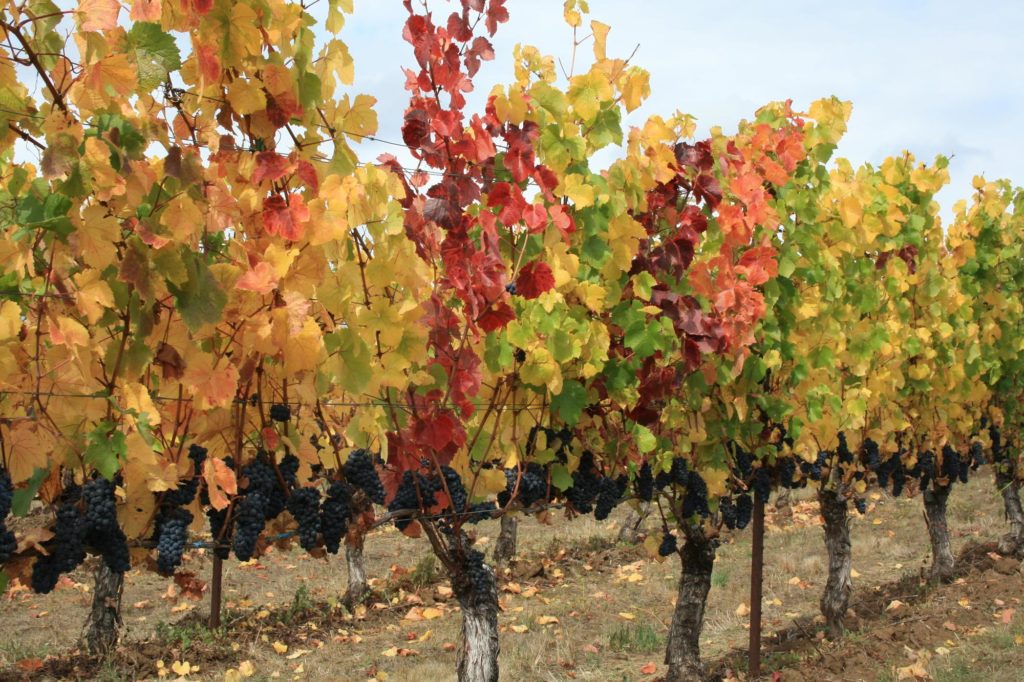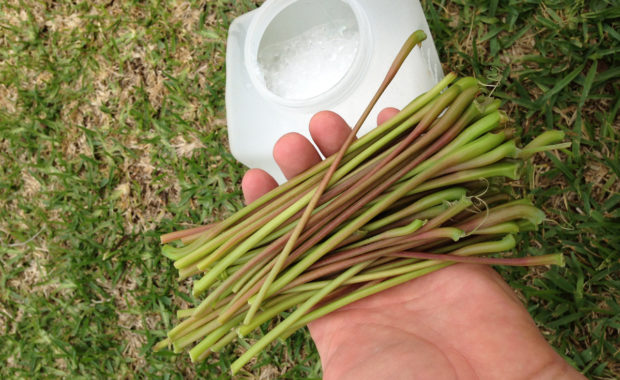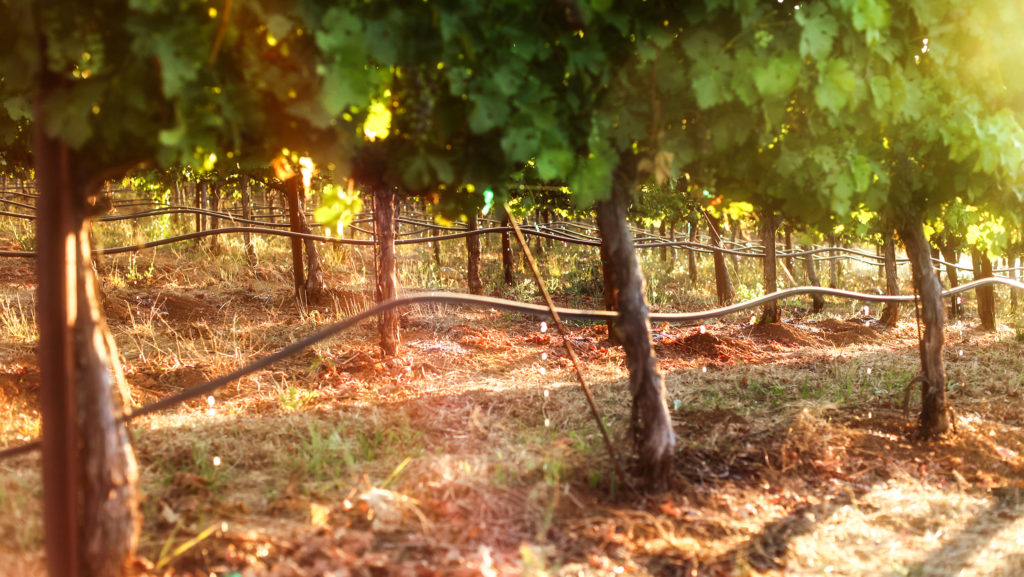Ask a viticulturist: How do I manage my Red-Blotch-infested vineyard?
I have a vineyard with a fair amount of Red Blotch in it. It’s not enough to justify pulling the whole vineyard. Can I manage those vines differently so that I get a quality crop in the meantime?
Thanks for reaching out! In response to your question, I’ll be pulling from one of Mark’s articles, originally published here.
Red blotch virus seems to be ubiquitous. Perhaps because I’m a consultant and I get called into solve problems, I seem to see more vineyards with red blotch-like symptoms than vineyards without. And though we’ve tested many vineyards and some test clean, so many tests confirm the presence of the virus that I feel like we are drowning in the disease.
Unlike other virus diseases, this one is particularly problematic. Like leafroll disease, also caused by a virus, leaves turn red and lose their ability to photosynthesize. Hence, sugar production is diminished as the canopy turns a bright shade of crimson, or similar hue. Also like leafroll disease, phenolic maturity slows down and color and mouthfeel components are difficult to attain. But red blotch is way worse than leafroll. We’ve lived with leafroll for a long time and, though it can be annoying and eventually economically damaging, it’s nothing compared to red blotch. If leafroll is a hammer, red blotch is a wrecking ball.

Besides the striking red leaf symptoms, the first thing growers and wineries usually discover about red blotch-affected vineyards is the failure to accumulate sugar past a given point. This varies, of course, but usually is found to be somewhere between 21 and 23 Brix. Because sugar accumulation ceases prematurely, for fruit to attain higher brix, the fruit often dehydrates and begins to shrivel to concentrate the sugars. We all can agree that that’s not really ripening.
What’s worse, in many ways, is that red blotch virus interferes with the berry’s secondary metabolism, responsible for flavor precursors, aroma precursors and perhaps most important, phenolic production. Color, mouthfeel, structure, and overall flavor and aroma intensities can be dramatically impacted by red blotch. Those are things that can’t be remedied in the winery. One simply cannot make great wine with grapes from red blotch affected grapes. That is if the virus concentration (titer) in the vines is high enough to impact the fruit dramatically enough.
Initially, growers and wineries may simply let fruit hang longer, in hopes that fruit color, tannins, etc., will attain their desired profiles. Early on, when virus titer is low, hang time may indeed allow fruit to be harvested within the desired characteristics. But, eventually, the virus will win and no amount of time on the vine will produce the desired fruit composition.
It’s this window of time, before the virus impacts the vine so dramatically that it materially devalues the fruit, where the grower wants to milk as many years out of the vineyard as possible before tearing it out. Replanting is expensive and a financial burden. You already knew that. But, what can we do to manage a vineyard to get those extra years of production?
It’s all about the ripening
Red blotch affects ripening in fundamental physiological ways, as was recently discovered[i]. One can imagine that the loss of chlorophyll pigment in the leaves would result in a loss of sugar production in those leaves. That is a factor, but it is by no means as simple as that. There are impacts on biological processes that go beyond simple loss of chlorophyll. Nevertheless, from a practical standpoint, we can assume that the timing, incidence and severity of leaf discoloration will correlate rather well with inability of fruit to accumulate sugar.
The effects of secondary metabolism (which for practical purposes are those processes that produce the berry’s flavor and aroma precursors and its phenolics) are perhaps even more profoundly impacted. Researchers found that transcription and post-transcription processes of ripening-related genes are suppressed in red-blotch-affected vines, and suppression of those genes causes, in part, the reduction of phenolic and other compounds. Red blotch impacts hormonal metabolism, including abscisic acid (ABA) and hampers hormones’ effects on berry metabolism. I mention ABA because it is one of the more important stress hormones (plant growth regulators) in the vine and its impact on fruit ripening is profound. It is considered a major trigger for fruit ripening and it also is associated with stimulating transcription of ripening genes to produce the infrastructure necessary for the berry’s secondary metabolism.
[i] Blanco-Ulate, B. et al. 2017. Red blotch disease alters grape berry development and metabolism by interfering with the transcriptional and hormonal regulation of ripening. Journal of Experimental Botany. 68(5): 1225–1238.

So, how do we manage vineyards with red blotch? Well, we don’t know for sure, but I am offering my opinion here and it’s something I have been doing with my own clients and will continue to determine if these things are having a measurable effect. Keep in mind that some of my suggestions here have been dismissed by researchers already, but in my opinion, perhaps dismissed too quickly. Since the effect of red blotch is both on sugar accumulation and secondary metabolism, I’ll offer my opinions separately though they both need to be considered.
Sugar accumulation ripening
In dealing with sugar accumulation issues, my feeling is that we need to keep the leaves functional as long and as much as possible and control the balance between functional leaf area and crop load. While researchers claim that crop reduction in red blotch vineyards does not improve Brix increase, I have to imagine there is a relationship, though I imagine it is more of a threshold response than a linear, continuous response. In other words, over-cropping a vineyard will hamper its sugar accumulation in a healthy vineyard, but in a compromised red blotch vineyard, that threshold for sugar accumulation impairment must be lower. So, your crop level target almost certainly has to be set lower than for a healthy vineyard.
Keeping leaves functional longer is not necessarily straightforward. But we need to consider the factors that keep photosynthesis going as the leaves age. Water stress, at least excessive water stress, can cause stomata to close and possibly leaves to drop, so excessive water stress during the ripening phase can be counterproductive to fruit sugar accumulation. But I want to make it clear that I do believe that water stress can actually improve ripening in red blotch vineyards. More about that to come.

Nutritionally, we need to make sure leaves are at adequate levels of macronutrients, with special attention paid to both nitrogen and potassium, as those two nutrients tend to decline most often in leaf tissue from bloom to veraison and especially after veraison. Supplying a little extra nitrogen around the time of veraison may help leaves stay functional, at least marginally so, so they continue to photosynthesize as long and as much as possible. There is little negative consequence to the application of a modest amount of nitrogen around veraison. As long as the application does not stimulate new vegetative growth, nitrogen will not impact wine quality and, in fact, could boost the yeast-assimilable nitrogen content of the grape must. That said, nitrate itself does inhibit anthocyanin formation, so don’t apply N at high rates and if levels at veraison are sufficient, don’t automatically apply nitrogen. Remember, we are fighting some difficult symptoms and we have to make some compromises.
Potassium can be important also, as it is used to modulate stomatal opening and closing as well as activating many enzymes in the plant. Boosting potassium late in the season is a double-edge sword. It may indeed maintain photosynthesis as leaves age and become more impacted by virus, but potassium in the vascular system gets directed into the berry during ripening. Excessive juice potassium can cause problems in the winery with elevated wine pH, which is not always easily corrected by acidulation. But, on the other hand, if potassium is deficient and when combined with the effects of virus, extended hang time can also have the consequence of elevating juice pH and reducing juice acidity.
Best practice includes testing tissue (I prefer petiole tissue but blade tissue is also fine) not only at bloom but at veraison to get an assessment of vine nutritional status and making corrections at that time to elevate those nutrients where they should be and, perhaps, just a little bit more than for normal vines.
Secondary metabolism ripening
Since red blotch affects hormonal pathways and expression of ripening enzymes, we want to do everything in our power to increase specific hormone levels and to stimulate the expression of ripening enzymes. At the risk of repeating myself from last month’s column, allow me to do just that, albeit briefly.
Our friend ABA plays such a big role in stimulation of ripening, it only makes sense that we want to help it along as much as possible to counteract the suppression of it by our enemy, red blotch. I mentioned above that excessive water stress can hamper photosynthesis and thereby retard sugar accumulation, which we want to avoid.
But carefully timed water stress will stimulate production of ABA and, thereby, stimulate the ripening enzymes we need for secondary berry metabolism. This is really the practice that I use for all my vineyards, but here it is even more important. Water stress just prior to and during veraison will stimulate berry ripening through its stimulation of ABA production, so targeted water stress during lag phase and through the completion of veraison is the practice I prefer. I do this for healthy vineyards, so it makes sense to do it for red blotch vineyards. The difference, however, is that I want to relax the post-veraison water stress level to a greater degree for red blotch vineyards than for healthy ones.

In addition to prescribed water stress management (let’s not call it deficit irrigation please), what else can we do to reduce the effects of red blotch? Good canopy management is crucial. Getting the fruit zone into shape on time is perhaps more important for these diseased vineyards than for healthy ones. Providing acceptable light into the fruit zone stimulates color and other phenolics in the skin and also reduces vegetative character in some varieties. So, leaf and lateral removal (in moderation), shoot tucking and wire lifting are important and their timing is of greater importance for sick vines than for healthy ones. That means canopy management must be practiced intensively as soon as fruit sets on the vine. If you delay, you are just exacerbating the effects of red blotch.
Some spray materials that may have a stimulating effect on ripening. Application of ABA itself at veraison may help, but my feeling is that it needs to be sprayed on foliage rather than fruit to get the desired effect. Just stay within the labeled rate to avoid negative consequences such as leaf drop or reduction in photosynthesis.
Other materials may be used as a foliar application at veraison, such as the LalVigne® product I mentioned before, which is a deactivated yeast product that stimulates the vines’ response to pathogen attackers (without actually being a pathogen). The biofungicide Regalia® is a plant extractive that also stimulates the plant’s stress response and it may have a similar effect. Another product called BluVite claims to promote fruit ripening, but rather than a foliar spray, it’s a material applied to the soil that stimulates native soil microbes and improves overall vine health. We don’t know yet if these products will have the desired effect of counteracting red blotch’s attacks on berry secondary metabolism. We are testing some this year, but it may take a while before we really know their efficacy.
We are fighting a losing war with these red blotch-ed vineyards. That is for certain. But vineyards are expensive, so perhaps we can win a few battles before we face the inevitability of giving into the virus. I’d like to think that is possible.
Photo credits
Gaffney, R. (n.d.). Beating Red Blotch. Oregon Wine Press – dedicated to Oregon wine, pinot noir, food, vineyards, winemakers, and insider-industry happenings. https://www.oregonwinepress.com/beating-red-blotch.
Gruener, Donald. Written by Fred Swan. (2018, July 6). 3 Myths About Irrigation and Dry Farming. SevenFifty Daily. https://daily.sevenfifty.com/3-myths-about-irrigation-and-dry-farming/.
Patricia Skinkis (https://extension.oregonstate.edu/people/patricia-skinkis) Viticulture Extension Specialist, Justin Litwin Graduate Research Assistant Oregon State University, Litwin, J., Assistant, G. R., & University, O. S. (2019, March 1). Extension Service. Red Blotch Disease. https://extension.oregonstate.edu/node/113146/printable/print.
Westover, Fritz. Grapevine Petiole Sampling. Virtual Viticulture Academy. (2021, May 5). https://www.virtualviticultureacademy.com/grower-guides/grapevine-petiole-sampling/.
(Main photo) Zalom, et al. North Central IPM Center. Red Blotch. (n.d.). https://www.ncipmc.org/projects/pest-alerts1/red-blotch/.


